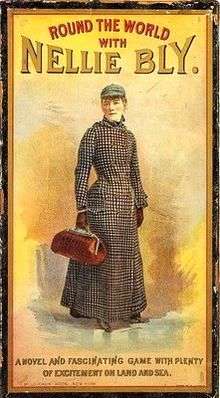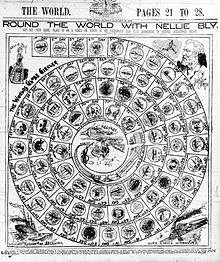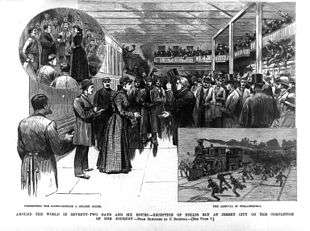Around the World in Seventy-Two Days
 "Round the World with Nellie Bly" board game box | |
| Author | Nellie Bly |
|---|---|
| Country | United States |
| Language | English |
| Genre | Non-fiction |
| Publisher | Pictorial Weeklies |
Publication date | 1890 |
| OCLC | 4363117 |

Around the World in Seventy-Two Days is a book by journalist Elizabeth Jane Cochrane, writing under her pseudonym, Nellie Bly. The chronicle details her 72-day trip around the world, which was inspired by the book, Around the World in Eighty Days by Jules Verne. She carried out the journey for Joseph Pulitzer's tabloid newspaper, the New York World.
Journey
In 1888, Bly suggested to her editor at the New York World that she take a trip around the world, attempting to turn the fictional Around the World in Eighty Days into fact for the first time. A year later, at 9:40 a.m. on November 14, 1889, she boarded the Augusta Victoria, a steamer of the Hamburg America Line,[1] and began her 24,899-mile journey.
She brought with her the dress she was wearing, a sturdy overcoat, several changes of underwear and a small travel bag carrying her toiletry essentials. She carried most of her money (£200 in English bank notes and gold in total as well as some American currency)[2] in a bag tied around her neck.[3]
The New York newspaper Cosmopolitan sponsored its own reporter, Elizabeth Bisland, to beat the time of both Phileas Fogg and Bly. Bisland would travel the opposite way around the world.[4][5] To sustain interest in the story, the World organized a “Nellie Bly Guessing Match” in which readers were asked to estimate Bly’s arrival time to the second, with the Grand Prize consisting at first of a free trip to Europe and, later on, spending money for the trip.[3][6]
On her travels around the world, Bly went through England, France (where she met Jules Verne in Amiens), Brindisi, the Suez Canal, Colombo (Ceylon), the Straits Settlements of Penang and Singapore, Hong Kong, and Japan. The development of efficient submarine cable networks and the electric telegraph allowed Bly to send short progress reports,[7] though longer dispatches had to travel by regular post and were thus often delayed by several weeks.[6]
Bly travelled using steamships and the existing railroad systems,[8] which caused occasional setbacks, particularly on the Asian leg of her race.[9] During these stops, she visited a leper colony in China[10][11] and she bought a monkey in Singapore.[10][12]
Homecoming
As a result of rough weather on her Pacific crossing, she arrived in San Francisco on the White Star liner Oceanic on January 21, two days behind schedule.[9][13] However, World owner Pulitzer chartered a private train to bring her home, and she arrived back in New Jersey on January 25, 1890, at 3:51 p.m.[7]

Bly arrived back in New York seventy-two days and six hours after leaving Hoboken. At the time, Bisland was still going around the world. Like Bly, she had missed a connection and had to board a slow, old ship (the Bothina) in the place of a fast ship (Etruria).[14] Bly's journey, at the time, was a world record, though it was bettered a few months later by George Francis Train, who completed the journey in 67 days.[15] By 1913, Andre Jaeger-Schmidt, Henry Frederick and John Henry Mears had improved on the record, the latter completing the journey in less than 36 days.[16]
In Popular Culture
- In season five, episode seven of Boardwalk Empire (set in 1897) the character Gillian Darmody reads aloud from this book, the only one she owns.
References
- ↑ Kroeger, Brooke. Nellie Bly – Daredevil, Reporter, Feminist. Times Books Random House, 1994, p. 146
- ↑ Kroeger, Brooke. Nellie Bly – Daredevil, Reporter, Feminist. Times Books Random House, 1994, p. 141
- 1 2 Ruddick, Nicholas. "Nellie Bly, Jules Verne, and the World on the Threshold of the American Age." Canadian Review of American Studies, Volume 29, Number 1, 1999, p. 5
- ↑ Barcousky, Len. "Eyewitness 1890: Pittsburgh welcomes home globe-trotting Nellie Bly", Pittsburgh Post-Gazette, August 23, 2009, accessed January 30, 2011
- ↑ "Society Topics of the Week.", The New York Times, November 24, 1889, accessed January 30, 2011
- 1 2 Kroeger, Brooke. Nellie Bly – Daredevil, Reporter, Feminist. Times Books Random House, 1994, p. 150
- 1 2 Ruddick, Nicholas. “Nellie Bly, Jules Verne, and the World on the Threshold of the American Age.” Canadian Review of American Studies, Volume 29, Number 1, 1999, p. 8
- ↑ Ruddick, Nicholas. “Nellie Bly, Jules Verne, and the World on the Threshold of the American Age.” Canadian Review of American Studies, Volume 29, Number 1, 1999, p. 6
- 1 2 Bear, David. “Around the World With Nellie Bly.” Pittsburgh Post-Gazette, November 26, 2006
- 1 2 Ruddick, Nicholas. “Nellie Bly, Jules Verne, and the World on the Threshold of the American Age.” Canadian Review of American Studies, Volume 29, Number 1, 1999, p. 7
- ↑ Kroeger, Brooke. Nellie Bly – Daredevil, Reporter, Feminist. Times Books Random House, 1994, p. 160
- ↑ Kroeger, Brooke. Nellie Bly – Daredevil, Reporter, Feminist. Times Books Random House, 1994, p. 158
- ↑
- ↑ Ruddick, Nicholas. "Nellie Bly, Jules Verne, and the World on the Threshold of the American Age." Canadian Review of American Studies, Volume 29, Number 1, 1999, p. 4
- ↑ http://www.skagitriverjournal.com/WA/Library/Newspaper/Visscher/Visscher3-Bio2.html para 16
- ↑ New York Times, "A Run Around the World", August 8, 1913
- Marshall Goldberg, "The New Colossus," Diversion Books, 2014
External links
| Wikisource has original text related to this article: |
| Wikimedia Commons has media related to Around the World in Seventy-Two Days. |
- Nellie Bly's Book: Around the World in Seventy-Two Days, by Nellie Bly. London: Bretano's; New York: Pictorial Weeklies, 1890 at A Celebration of Women Writers
- Around the World in Seventy-Two Days at Project Gutenberg (Audio Book)
-
 Around the World in Seventy-Two Days public domain audiobook at LibriVox
Around the World in Seventy-Two Days public domain audiobook at LibriVox